Abstract
Antipili antibody (APA) was quantitated by enzyme-linked immunosorbent assay in the serum, urine, and vaginal secretions of 12 women with cystitis due to Escherichia coli. Pili were purified from the strain infecting each patient. The geometric mean titers of APA in serum taken at the initial visit were: immunoglobulin G (IgG), 23.7 +/- 3.9; IgA, 4.1 +/- 4.0; and IgM, 4.4 +/- 5.7. No consistent change was observed between samples obtained at 3 and 6 weeks. APA in serum from 10 control patients was assayed against a pool of pili assembled from the 12 infecting isolates. The geometric mean titers of the control sera were: IgG, 8.4 +/- 3.2; IgA, 9.6 +/- 2.4; and IgM, 0. Antipili IgG and IgM were significantly greater in the infected than in the control sera (P less than 0.05). APA was not detected in the urine or vaginal secretions from any infected or control patient. Antigenic relationships between the 12 infecting strains were investigated by indirect immune electron microscopy. All but 1 of 12 infecting strains shared antigenic determinants. Two patients had a second E. coli infection during the study. The pili of the reinfecting isolates showed partial antigenic cross-reactivity with the pili of the initial infecting bacteria. These observations indicate that although cystitis stimulates the development of serum APAs, it fails to stimulate local APA and thus may not engender any immunological barrier to subsequent recolonization.
Full text
PDF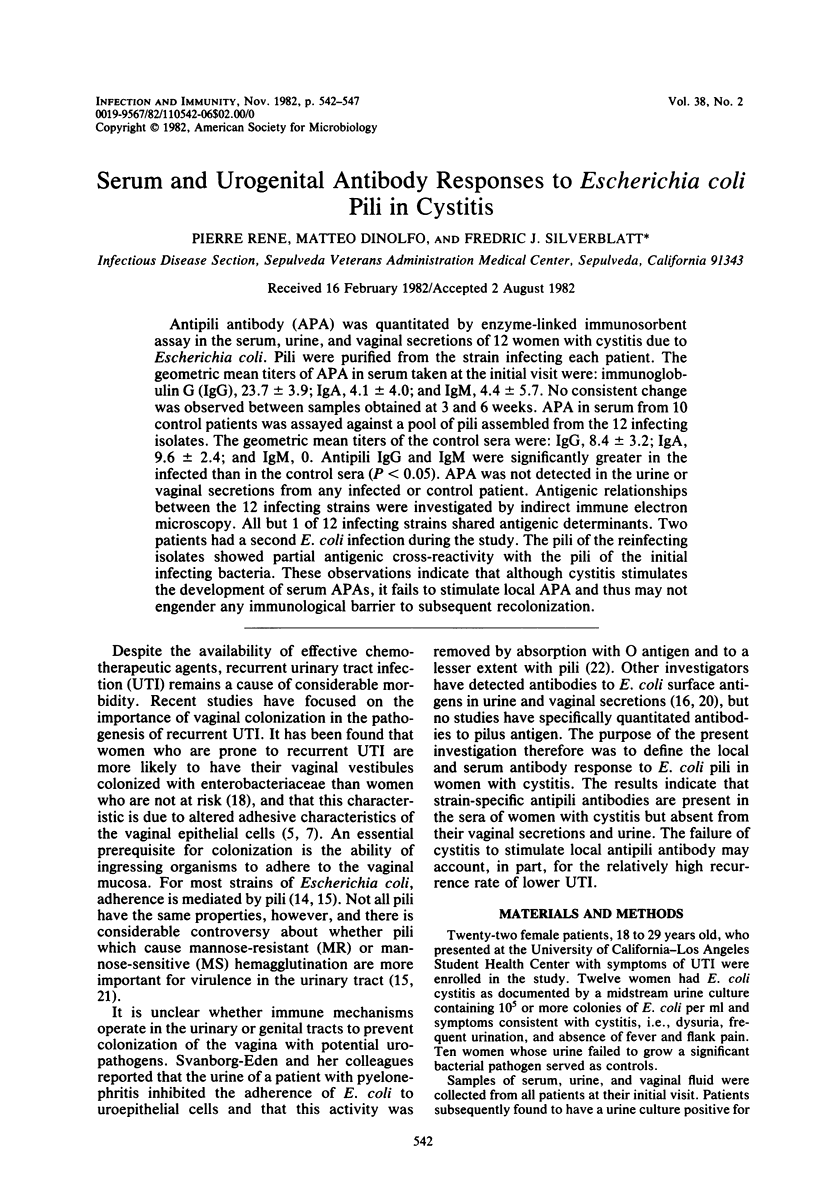
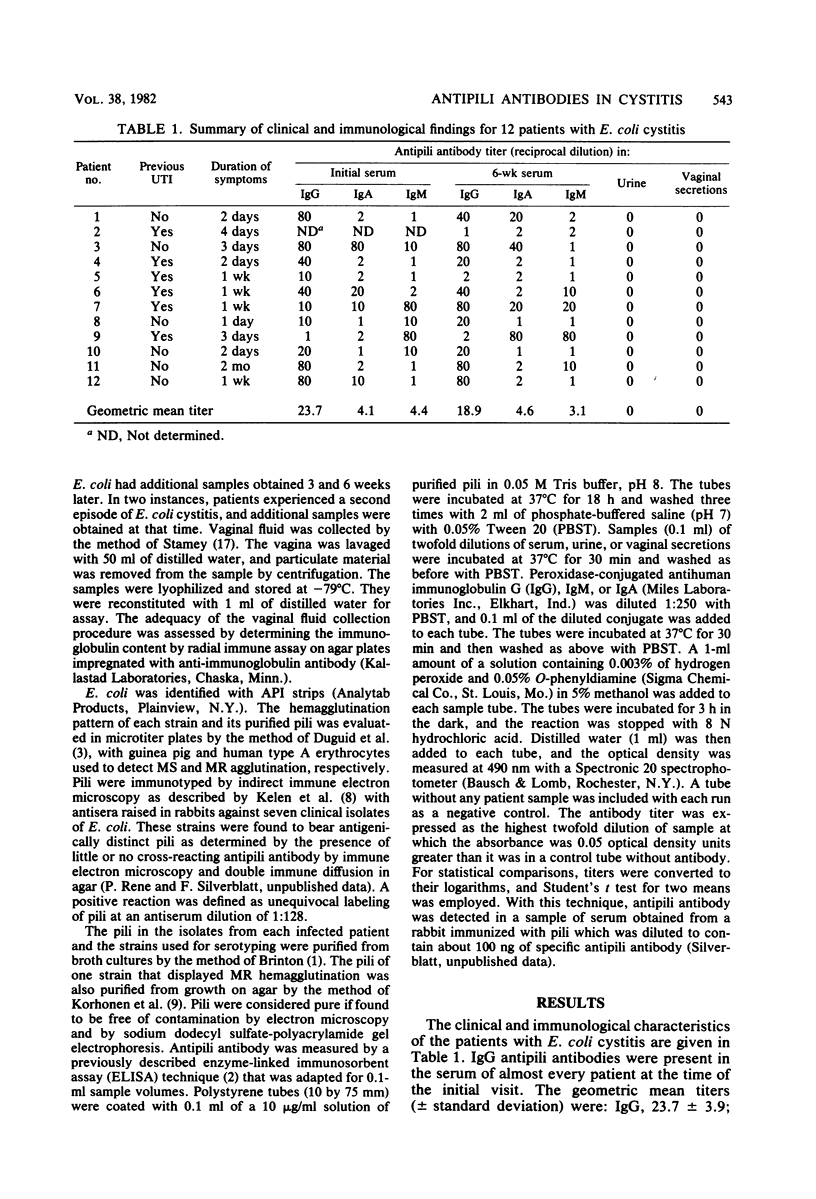
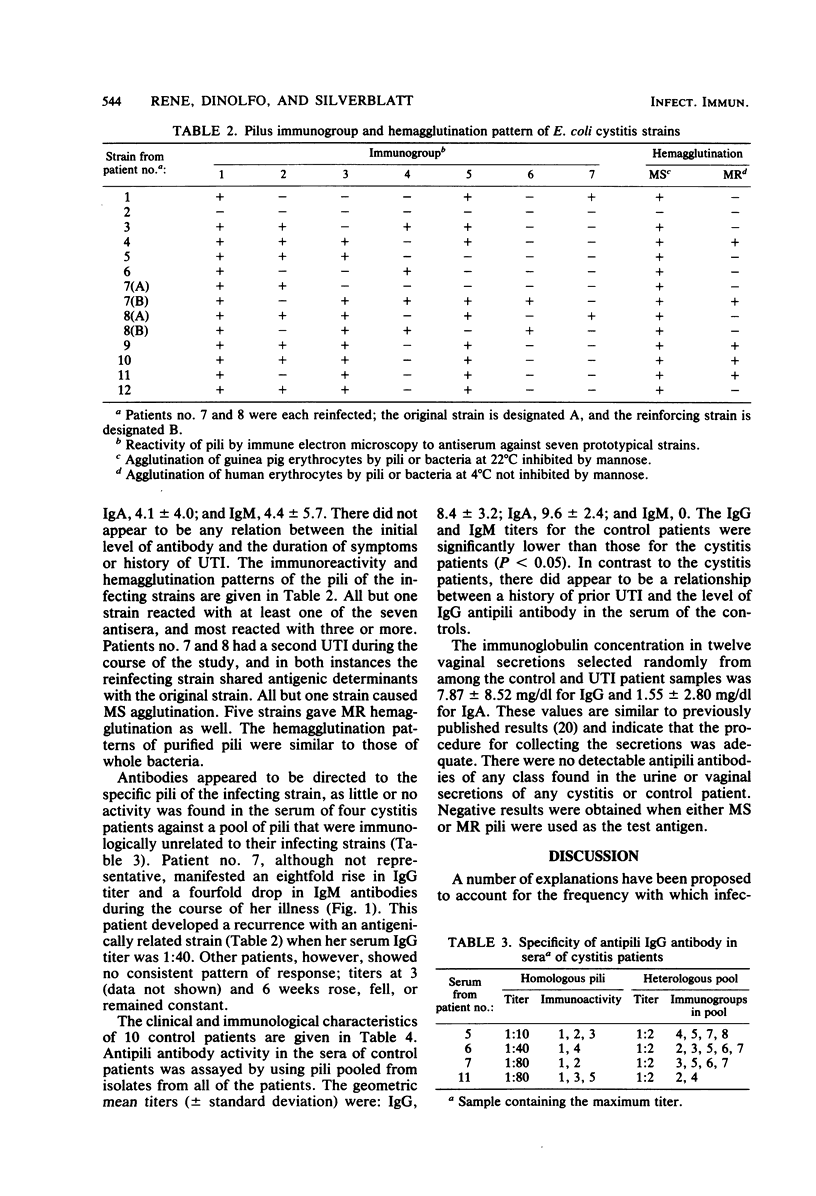
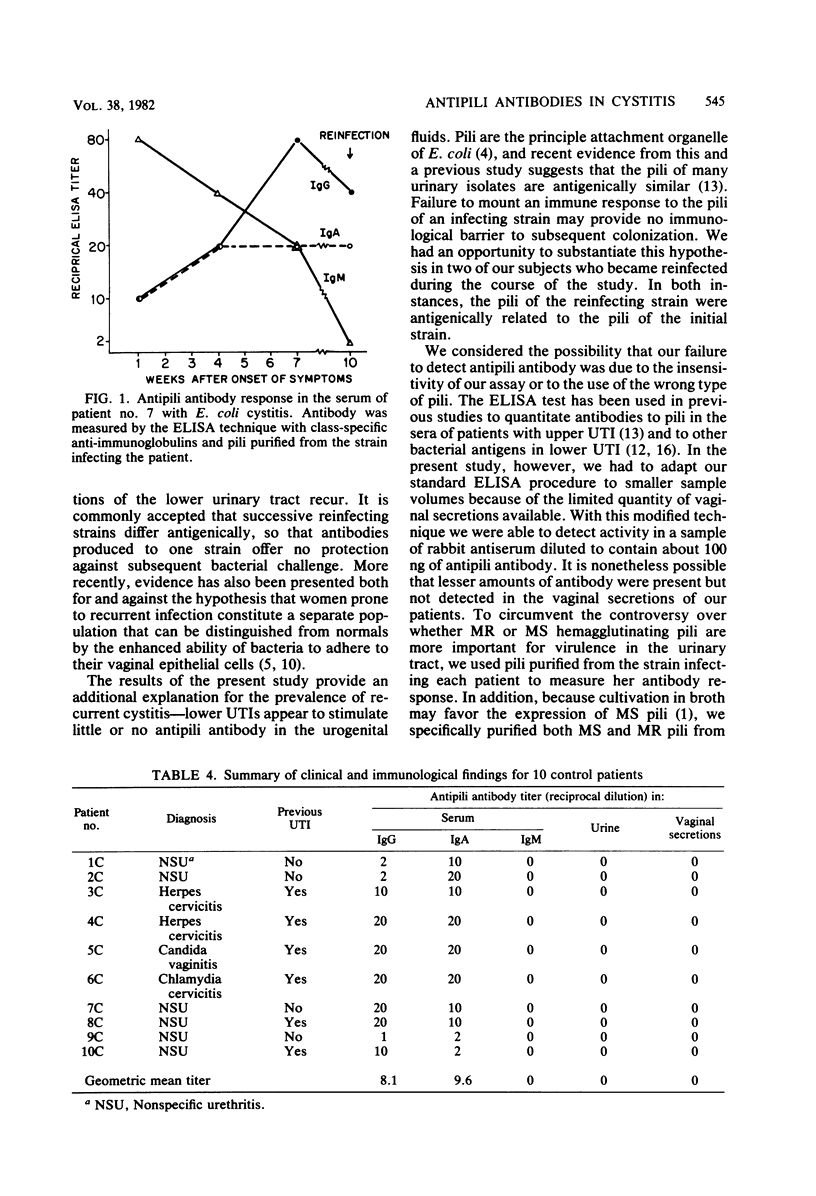
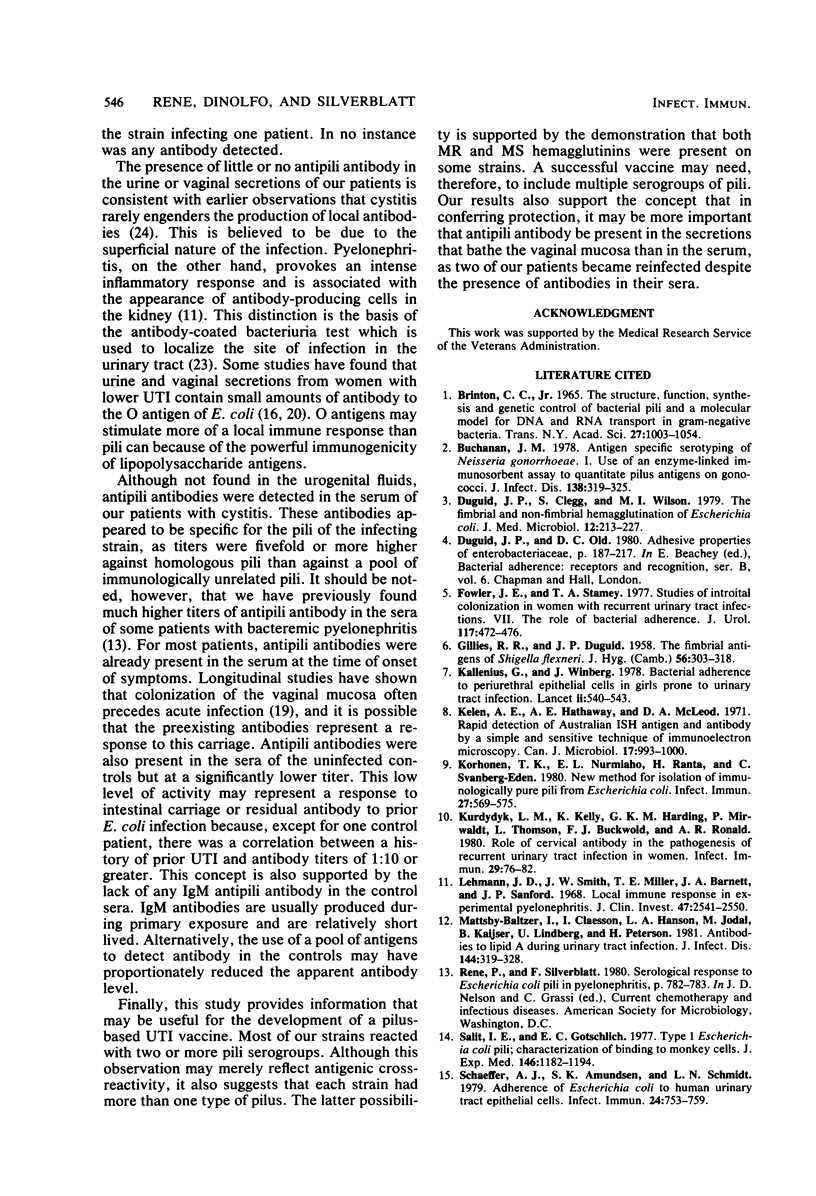
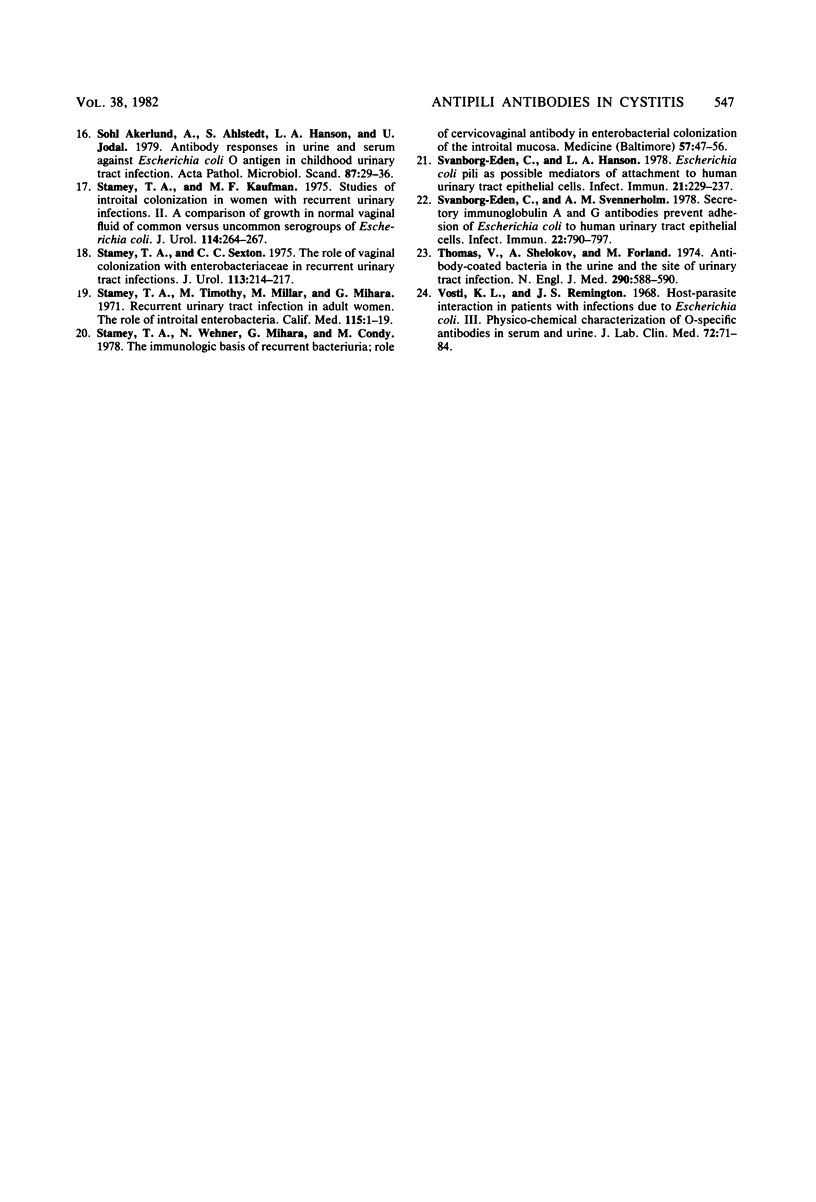
Selected References
These references are in PubMed. This may not be the complete list of references from this article.
- Akerlund A. S., Ahlstedt S., Hanson L. A., Jodal U. Antibody responses in urine and serum against Escherichia coli O antigen in childhood urinary tract infection. Acta Pathol Microbiol Scand C. 1979 Feb;87C(1):29–36. [PubMed] [Google Scholar]
- Brinton C. C., Jr The structure, function, synthesis and genetic control of bacterial pili and a molecular model for DNA and RNA transport in gram negative bacteria. Trans N Y Acad Sci. 1965 Jun;27(8):1003–1054. doi: 10.1111/j.2164-0947.1965.tb02342.x. [DOI] [PubMed] [Google Scholar]
- Buchanan T. M. Antigen-specific serotyping of Neisseria gonorrhoeae. I. Use of an enzyme-linked immunosorbent assay to quantitate pilus antigens on gonococci. J Infect Dis. 1978 Sep;138(3):319–315. doi: 10.1093/infdis/138.3.319. [DOI] [PubMed] [Google Scholar]
- Duguid J. P., Clegg S., Wilson M. I. The fimbrial and non-fimbrial haemagglutinins of Escherichia coli. J Med Microbiol. 1979 May;12(2):213–227. doi: 10.1099/00222615-12-2-213. [DOI] [PubMed] [Google Scholar]
- Edén C. S., Hansson H. A. Escherichia coli pili as possible mediators of attachment to human urinary tract epithelial cells. Infect Immun. 1978 Jul;21(1):229–237. doi: 10.1128/iai.21.1.229-237.1978. [DOI] [PMC free article] [PubMed] [Google Scholar]
- Fowler J. E., Jr, Stamey T. A. Studies of introital colonization in women with recurrent urinary infections. VII. The role of bacterial adherence. J Urol. 1977 Apr;117(4):472–476. doi: 10.1016/s0022-5347(17)58501-8. [DOI] [PubMed] [Google Scholar]
- GILLIES R. R., DUGUID J. P. The fimbrial antigens of Shigella flexneri. J Hyg (Lond) 1958 Sep;56(3):303–318. doi: 10.1017/s0022172400037803. [DOI] [PMC free article] [PubMed] [Google Scholar]
- Kelen A. E., Hathaway A. E., McLeod D. A. Rapid detection of Australia-SH antigen and antibody by a simple and sensitive technique of immunoelectronmicroscopy. Can J Microbiol. 1971 Jul;17(7):993–1000. doi: 10.1139/m71-157. [DOI] [PubMed] [Google Scholar]
- Korhonen T. K., Nurmiaho E. L., Ranta H., Edén C. S. New Method for isolation of immunologically pure pili from Escherichia coli. Infect Immun. 1980 Feb;27(2):569–575. doi: 10.1128/iai.27.2.569-575.1980. [DOI] [PMC free article] [PubMed] [Google Scholar]
- Kurdydyk L. M., Kelly K., Harding G. K., Mirwaldt P., Thompson L., Buckwold F. J., Ronald A. R. Role of cervicovaginal antibody in the pathogenesis of recurrent urinary tract infection in women. Infect Immun. 1980 Jul;29(1):76–82. doi: 10.1128/iai.29.1.76-82.1980. [DOI] [PMC free article] [PubMed] [Google Scholar]
- Källenius G., Winberg J. Bacterial adherence to periurethral epithelial cells in girls prone to urinary-tract infections. Lancet. 1978 Sep 9;2(8089):540–543. doi: 10.1016/s0140-6736(78)92880-5. [DOI] [PubMed] [Google Scholar]
- Lehmann J. D., Smith J. W., Miller T. E., Barnett J. A., Sanford J. P. Local immune response in experimental pyelonephritis. J Clin Invest. 1969 Nov;47(11):2541–2550. doi: 10.1172/JCI105936. [DOI] [PMC free article] [PubMed] [Google Scholar]
- Mattsby-Baltzer I., Claësson I., Hanson L. A., Jodal U., Kaijser B., Lindberg U., Peterson H. Antibodies to lipid A during urinary tract infection. J Infect Dis. 1981 Oct;144(4):319–328. doi: 10.1093/infdis/144.4.319. [DOI] [PubMed] [Google Scholar]
- Salit I. E., Gotschlich E. C. Type I Escherichia coli pili: characterization of binding to monkey kidney cells. J Exp Med. 1977 Nov 1;146(5):1182–1194. doi: 10.1084/jem.146.5.1182. [DOI] [PMC free article] [PubMed] [Google Scholar]
- Schaeffer A. J., Amundsen S. K., Schmidt L. N. Adherence of Escherichia coli to human urinary tract epithelial cells. Infect Immun. 1979 Jun;24(3):753–759. doi: 10.1128/iai.24.3.753-759.1979. [DOI] [PMC free article] [PubMed] [Google Scholar]
- Stamey T. A., Kaufman M. F. Studies of introital colonization in women with recurrent urinary infections. II. A comparison of growth in normal vaginal fluid of common versus uncommon serogroups of Escherichia coli. J Urol. 1975 Aug;114(2):264–267. doi: 10.1016/s0022-5347(17)67004-6. [DOI] [PubMed] [Google Scholar]
- Stamey T. A., Sexton C. C. The role of vaginal colonization with enterobacteriaceae in recurrent urinary infections. J Urol. 1975 Feb;113(2):214–217. doi: 10.1016/s0022-5347(17)59447-1. [DOI] [PubMed] [Google Scholar]
- Stamey T. A., Timothy M., Millar M., Mihara G. Recurrent urinary infections in adult women. The role of introital enterobacteria. Calif Med. 1971 Jul;115(1):1–19. [PMC free article] [PubMed] [Google Scholar]
- Stamey T. A., Wehner N., Mihara G., Condy M. The immunologic basis of recurrent bacteriuria: role of cervicovaginal antibody in enterobacterial colonization of the introital mucosa. Medicine (Baltimore) 1978 Jan;57(1):47–56. doi: 10.1097/00005792-197801000-00003. [DOI] [PubMed] [Google Scholar]
- Svanborg-Edén C., Svennerholm A. M. Secretory immunoglobulin A and G antibodies prevent adhesion of Escherichia coli to human urinary tract epithelial cells. Infect Immun. 1978 Dec;22(3):790–797. doi: 10.1128/iai.22.3.790-797.1978. [DOI] [PMC free article] [PubMed] [Google Scholar]
- Thomas V., Shelokov A., Forland M. Antibody-coated bacteria in the urine and the site of urinary-tract infection. N Engl J Med. 1974 Mar 14;290(11):588–590. doi: 10.1056/NEJM197403142901102. [DOI] [PubMed] [Google Scholar]
- Vosti K. L., Remington J. S. Host-parasite interaction in patients with infections due to Escherichia coli. 3. Physicochemical characterization of O-specific antibodies in serum and urine. J Lab Clin Med. 1968 Jul;72(1):71–84. [PubMed] [Google Scholar]


